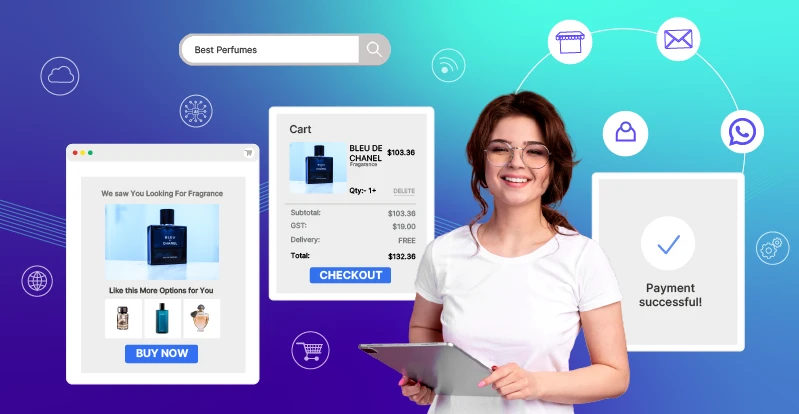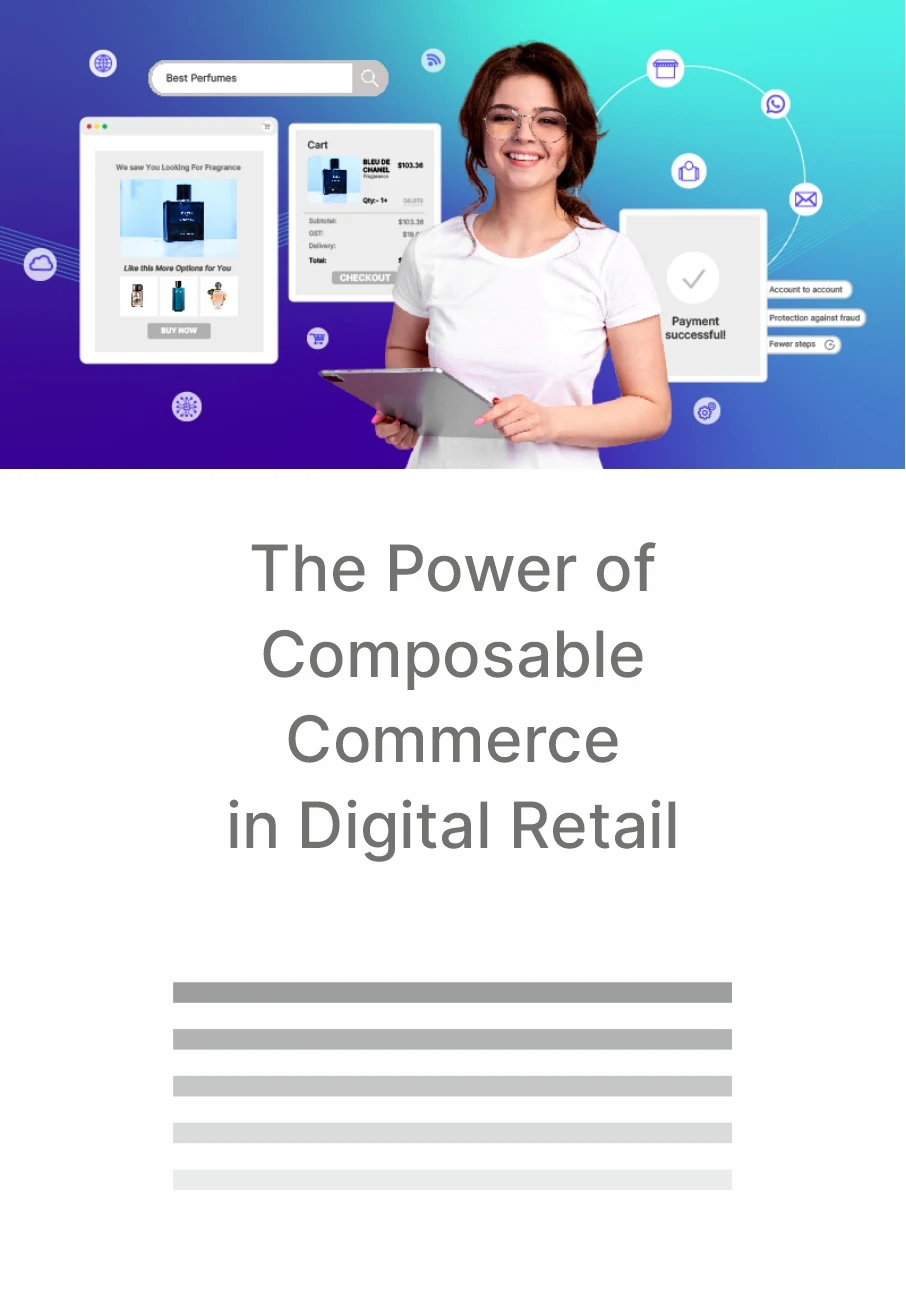The Power of Composable Commerce in Digital Retail

Table of Contents

Get The Print Version
Download a PDF version for easier offline reading and sharing with coworkers
In the digital age, the retail industry is constantly changing. The eCommerce industry is changing dramatically as a result of rising customer demand. Buyers are more aware than ever before. They want convenience, faster product delivery, and high-quality services delivered to their door.
However, obtaining this experience necessitates upgrading technology, as the retailer cannot meet end-user demand using a traditional approach. The need for composable commerce enters the story at this point.
According to recent research, 72% of US retailers were already adopting composable commerce by the middle of 2023, and another 21% intended to do so within the next year.
Composable commerce is made up of several updated technologies. It aids in the growth of your digital eCommerce business by providing customization, flexibility, and scalability. Let’s look at how composable commerce can change the game for your retail business and provide an excellent experience for new-age customers.
Transform your Retail Business with a Seamless PBC system
An essential element of online retail is the PBC (Payment, bills, and Checkout) system. It includes all of the procedures for processing payments, handling bills, and streamlining the consumer checkout process. The PBC system is essential for providing online retailers with a smooth, effective, and safe transactional experience in the context of composable commerce.
Composable commerce can effortlessly integrate flexible, modular components. They have an efficient PBC system, which plays a vital role in this architecture. It guarantees customized and seamless payment processing, providing a range of payment options and safe transactions for ensuring a consistent client experience with the various touchpoints.
A streamlined and more integrated online retail operation may be achieved by integrating an effective PBC system with other essential business components. Including CRM and inventory management, composable commerce can offer a smooth process for the retail business. This system makes an online retail organization profitable and customer-focused.
Key Components of Composable Commerce
Composable commerce involves some key components, i.e., known as MACH, which consists of microservices, API, Cloud, and headless. These four elements have a significant impact on digital retail. Let’s explore the core benefits of choosing these components.
Microservices
Microservices provide the fundamental structure for digital retail by taking a decentralized and modular approach. This framework divides complex retail operations into small, autonomous services.
By enabling agile development, scalability, and easier maintenance, it can improve the customer experience. For example, the product catalog microservice manages product information, whereas the user accounts microservice manages customer profiles.
Each section is dedicated to a specific business function. It enables retailers to quickly adapt to market demands and implement changes in their digital retail ecosystem.
API-first
An API-first approach in digital retail enables the integration of diverse, best-in-class solutions. Rather than relying solely on standardized, ready-made plugins, this strategy allows businesses to create a tech infrastructure tailored to their specific requirements.
By prioritizing APIs as the foundation, retailers can seamlessly connect and customize various services, fostering a more adaptable and tailored digital retail environment.
For example, retailers can use APIs to integrate their business with a third-party payment gateway, CRM, and recommendation system to provide a more personalized experience to end users.
Cloud
Cloud-native architecture in digital retail adapts automatically to meet business demands, ensuring fast performance and robust security. This ensures that customers have quick and dependable experiences regardless of fluctuations in traffic or data requirements.
For example, during sales, the cloud scales up server capacity to accommodate the increase in traffic, ensuring customers have a fast and secure shopping experience.
Headless architecture
Headless architecture separates front-end display from back-end management, enabling multiple customer touchpoints and ensuring a consistent, multi-channel customer experience.
For example, customers can browse products on a website, make purchases via a mobile app, or shop with a voice assistant, all while receiving a unified and personalized experience regardless of the device or channel they use.
Because of this decoupling, retailers can provide consistent and personalized interactions across multiple platforms, thereby improving the customer journey.
Composable Commerce is Transforming Digital eCommerce
With its high potential features, composable commerce is rapidly transforming the retail industry in the digital era. We have found some key areas where composable commerce has brought fantastic changes to online retail. Let’s have a look below:
Boost Customer experience

Composable Commerce transforms online retail by giving businesses more control over customer interactions. For example, an apparel retailer may customize product recommendations based on individual browsing patterns, quickly adjusting to changing market trends to remain relevant.
Integrating specialized solutions such as CRM systems and chatbots reduces vendor dependency while streamlining operations and elevating customer interactions. This adaptability enables the retailer to meet changing customer needs, resulting in higher retention rates and a more refined shopping experience, which fosters stronger brand loyalty.
Furthermore, Composable Commerce improves customer satisfaction by streamlining payment methods. The strategy improves the online shopping journey by providing various payment options and seamless checkout experiences, resulting in a more satisfying and personalized customer experience.
Simplified system
Retail businesses can create their websites and online stores more effectively using a strategic approach of composable commerce. This application offers eCommerce companies the best alternatives, efficiently optimizing their operations.
In retail operations, it provides customization, scalability, and flexibility. This approach helps businesses stay competitive and adapt to the changing needs of consumers by making it simple for them to experiment with new ideas and add new functionalities.
By removing the requirement for substantial custom development, it also lowers expenses, generally, by giving retail enterprises the resources they need to adapt and grow in the contemporary market, composable commerce streamlines operations.
Modular Scalability
Modular scalability in digital retail has the most crucial role in enabling quick and effective growth with highly customized consumer experiences. It helps to improve the customer Experience (CX) with the potential to reinvent the online business completely. Due to the growing demand for personalized experiences and flexible revenue models, the end-users can get the most delightful experience.
Composable commerce can offer this service that can be quickly adjusted to meet the changing needs of clients and online eCommerce. This strategy offers the ultimate flexibility and adaptability to firms in the dynamic market. It satisfies the need for customized, superior experiences while permitting smooth and swift growth.
End-to-end personalization
Composable commerce offers Hyper-personalization that helps to boost the end-user’s experience. For example, retail brands of beauty products can include AI-driven recommendation engines to make custom product or content recommendations based on their data.
It will help to improve user engagement and raise the possibility of conversion, making the purchasing process more accessible and fulfilling. Businesses may easily integrate these refined personalization capabilities with a composable approach to ensure a positive outcome.
Easy integration
Integration is a major need for any eCommerce business. Composable commerce allows the eCommerce business to integrate with the most reliable third party to simplify their different operations, including payment process, CRM, marketing, and sales, to ensure better outcomes.
It will enable seamless communication between various systems; for example, a grocery store can integrate its business with the CRM system to optimize back-end operations and customer relationships. It will help them to connect with effective inventory management software to ensure a synchronized and efficient supply chain for their business.
Hence, connecting with the most reliable tools can help streamline the retail business. It will also help save operational costs and ensure higher returns and sales for their eCommerce business.
Omnichannel support

Today’s customers demand multi-channel support; they want to connect with their preferred retail store from any device. It can be their mobile phone for accessing the products from their applications, website, store, and social media account.
A traditional approach will not be able to offer a seamless experience like this. The customers expect to gain information from where they left in another device or channel. To make this process possible, the implementation of omnichannel is essential.
A recent study found that retailers who don’t offer multi- channels can lose up to 30% of their sales.
With the help of a composable commerce approach, this process can be conducted. This approach will effectively improve the omnichannel co-ordination and offer the best outcome for the end-users.
For example, A retail company that uses composable commerce can combine inventory systems with social media, mobile apps, in-store point of sale, and online platforms. Using this method, a consumer who begins their product research online may easily switch to the mobile app and locate goods they have already viewed stored in their cart.
It will ensure consistent data across channels, provide a unified experience, fulfill continuity expectations, and improve consumer happiness in the omnichannel retail environment. Hence, by implementing composable commerce, the retail business can offer a smooth omnichannel experience to the end-users.
Success story
Composable commerce has transformed the eCommerce business process for various retail brands. Let’s explore a few of them below:
Serena & Lily
Serena & Lily, a US-based home interior firm, moved away from monolithic processes due to difficulties with SKU control and product configuration with their custom furniture. They chose the modular business, looked for a flexible, dynamic solution, and boosted their possibilities.
Due to its scalability and versatility, composable commerce became the preferred option. Their complicated merchandising requirements were met API-first, decoupled design, which allowed for dynamic bundling, customized setups, and handling many SKU variations.
The decision by Serena Lily to switch to composable commerce is an example of a long-term, forward-thinking approach that offers the flexibility required for changing digital commerce tactics.
Jenson USA
Jenson USA-based online bicycle shop was struggling with data analysis and personalized client experiences. With the help of composable commerce solutions, they have been successfully able to customize their search results, allowing them to boost their visitors.
This strategy enhanced overall sales and conversion rates by enabling tailored customer experiences. They can also design customized marketing efforts that produce more focused and successful results. This adoption helped them to increase revenue and made purchasing easier and more customized, improving its effectiveness in raising customer engagement and boosting sales.
Hence, connecting with the composable commerce approach has proven to be a successful one for Jenson and helped them to boost their business to a higher level.
Get a composable commerce service for your digital retail
Being flexible and adaptable is essential for success in the fast-paced digital retail world of today. Composable commerce services offer versatile solutions to businesses looking to expand and adjust to the constantly shifting demands of the retail industry.
Customers’ evolving needs drive the need to choose composable commerce to create a tailored, scalable e-commerce environment that satisfies your particular needs. Regardless of your size as an online store, deploying composable commerce is also beneficial for providing individualized marketing, customer analytics, inventory management, payment processing, and other essential components that can all be chosen with this method.
According to Gartner, by 2026, companies that have put in place systems for reusing modular digital commerce modules would see a 60% increase in the rate of digital innovation compared to 2022, and here, the need for composable commerce comes to the story.
Adopting composable commerce into practice has many advantages. A few benefits include enhanced customer experiences, streamlined processes, cost-effectiveness, and the ability to adapt to changes in the market swiftly.
Implementing composable commerce is associated with lots of benefits. Improved client experiences, simpler operations, cost-efficiency, and the flexibility to adjust in reaction to market changes quickly are just a few of the many advantages. Composable commerce increases consumer loyalty and gives your company the edge to stay ahead in a dynamic industry.
Based on a recent analysis, “more than 95% of retail business is already considering composable commerce as the future of business”.
Composable commerce is growing and has many opportunities for the future. This is the right time to invest in this robust approach. With the help of this approach, you will be able to offer a bespoke solution to your end-users.
Consulting a composable commerce specialist can be helpful. Look for the best provider to stay on the top. Enhance the customer experience to ensure a higher return on investment. Welcome the future of retail business with the top-graded composable solutions.



